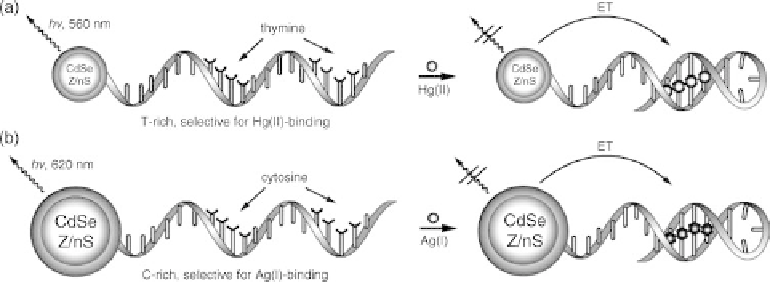Chemistry Reference
In-Depth Information
9.6.2 Sensor Applications
Examples that are probably nearer to the real world application of metal base pairing
systems may be found in the field of molecular sensing. In this direction, Willner
et al.
reported a system based on Hg(II)-selective, T-rich- or Ag(I)-selective, C-rich-DNA
single strands bound to luminescent CdSe/ZnS quantum dots (Figure 9.19) [56]. In the
absence of the metal ions, irradiation of the nanoscopic core-shell particles results in
the emission of light with a wavelength specific for the size of the quantum dot. After the
addition of the appropriate transition metal ions that bind to the DNA sequences, this fluo-
rescence is quenched, thereby signaling the binding event. The two systems depicted in
Figure 9.19a and b were found to behave independently, which was used to realize the
functions of logic gates with “AND” as well as “OR” signal processing behavior.
9.6.3 Magnetism and Electrical Conductance
Towards the application of metal base pairs in the emerging fields of molecular magnet-
ism and electronics, a few steps have been undertaken so far. As mentioned in Sec-
tion 9.5.2, linear arrays of directly stacked hydroxypyridone-Cu(II) base pairs were
found to result in an ferromagnetic coupling of all involved Cu(II) centers [48]. Similar
EPR measurements were performed for stacks of two salen-Cu(II) base pairs in DNA
which showed that, in this case, anti-ferromagnetic coupling was predominant [57].
These experimental studies were supported and interpreted by high-level DFT quantum
mechanical modeling studies, which showed that the stacked hydroxypyridone-Cu(II)
complexes are tightly linked by two of the ligand's oxygen atoms acting as bridging
ligands (Figure 9.20a). This results in an orthogonal arrangement of the single occupied
molecular orbitals [58]. Consequently, the absence of a continuous exchange path along
the bridging ligands results in ferromagnetic coupling according to the Goodenough-
Kanamori rules of magnetic superexchange. In contrast, the salen-Cu(II) base pairs
adopt an arrangement in which the energetically preferred anti-ferromagnetic coupling
is the result (Figure 9.20b).
Figure 9.19 Quantum dot-DNA hybrid structures with (a) specificity for Hg(II) and (b) speci-
ficity for Ag(I) deliver a change in fluorescence intensity upon metal addition as a readout
signal.

Search WWH ::

Custom Search